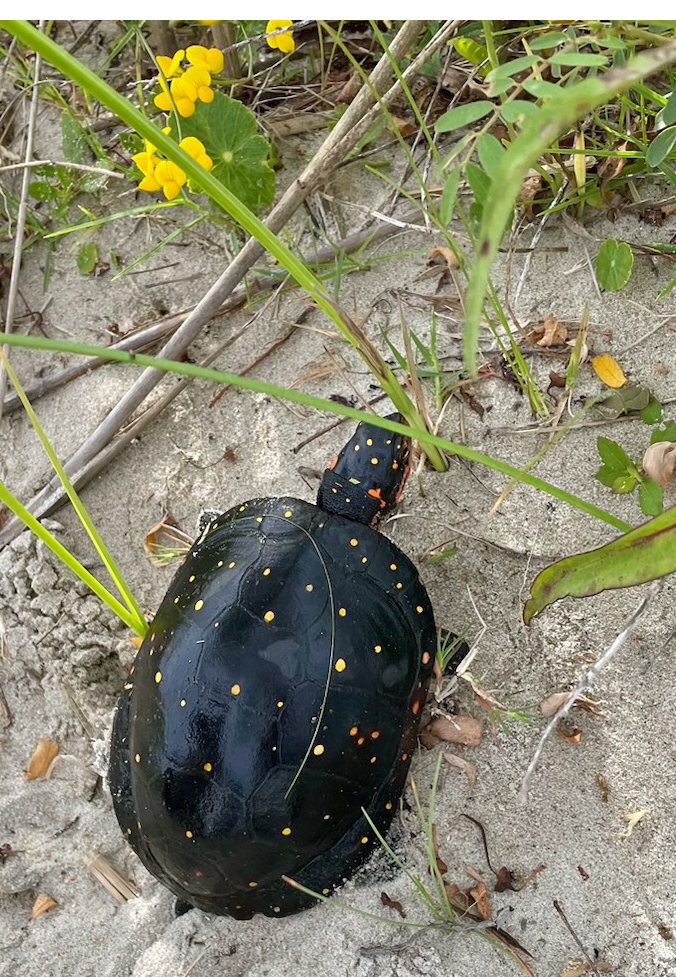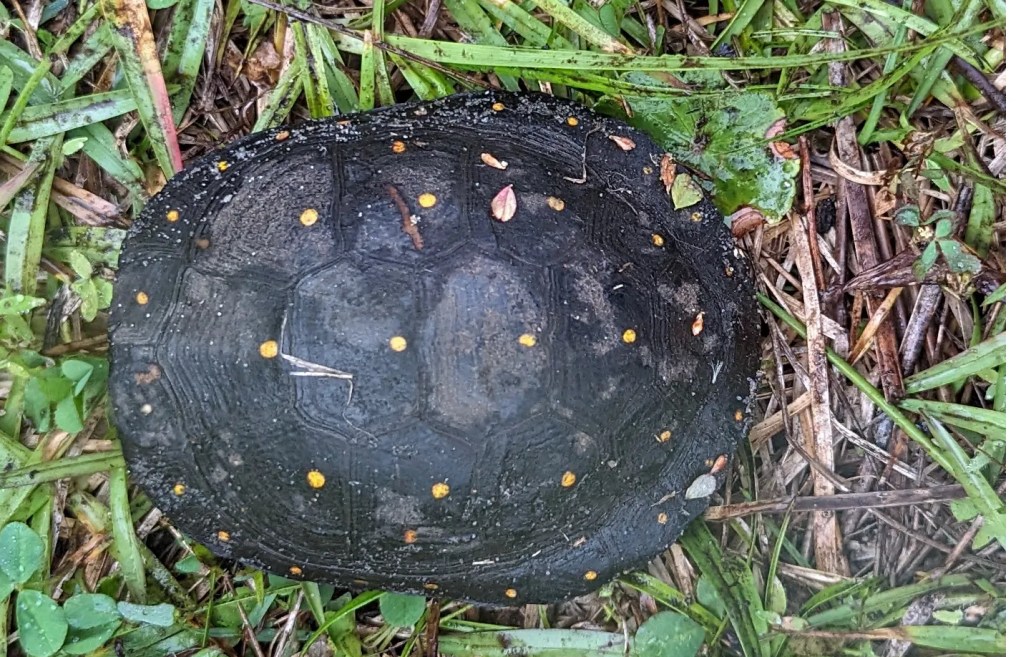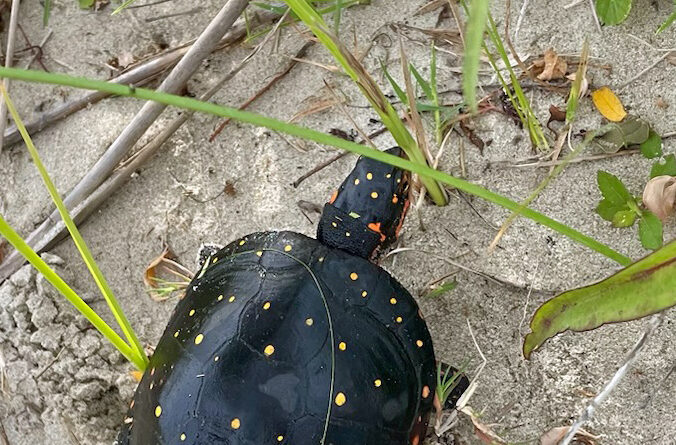Spotted on Ocracoke: Okay, spotted turtle

Written by Peter Vankevich
While driving on NC 12 near the airport earlier this year, I saw a small dark object on the road. As I suspected, it was a turtle. I quickly turned around, picked it up and dropped it near the dirt grass across the highway where it was headed. As I was tired of being pregnant, I quickly took a phone photo and continued on my way. Later when I looked at it I realized it was a spotted turtle (Clemmys guttata).
This black turtle gets its name from having yellow spots, rarely from none at all up to 100 appearing on the carapace (upper part), head, neck and limbs. Each turtle has a unique pattern and number of yellow spots on its shell and skin as shown by two people photographed in Ocracoke. These spotting patterns are used by other researchers to identify and track individual turtles over time.
The evolutionary reasons for the yellow spots in these turtles are not fully understood, but they may serve as a camouflage mechanism that mimics sunlight filtering through the water and vegetation that helps them to meet in their environment.
The male has a brown chin, brown eyes and a long, bushy tail. The female has a yellow chin, orange eyes and a shorter tail than the male. Females tend to be slightly more spotted than males. Yellow spots tend to be larger in people living in the northern part.
It is one of the smallest North Carolina turtles with less than 5 inches of carapace (shell) length. It is a rare turtle found in the western regions of the small country. Spotted turtle habitats throughout the Coast and eastern Piedmont are marshes, wetlands, Carolina bays, ditches, and slow-moving streams. They tolerate slightly salty water, especially in coastal areas like Ocracoke where fresh water and salt water meet.
Their extensive North American range includes Maine and southeastern Ontario and west through New York, Pennsylvania, Ohio, northern Indiana and Michigan to northeastern Illinois. They occur along the Atlantic coast down to central Florida.
Like many turtle species around the world, they have experienced significant declines in many areas due to habitat loss and the fragmentation of roads that separate populations and make it difficult to find a mate. Another reason for their decline is linked to chemical pollution from pesticides, fertilizers, and agricultural and industrial runoff. This pollution can directly affect the turtles or destroy the plants and animals they depend on for food.
Like the story of the diamondback terrapin, the invasive plant Phragmites (Phragmites australis) also known as common reed can be a threat to spotted turtles. This aggressive plant can create dense, monocultural habitats in wetlands, negatively affect water flow and quality, remove native vegetation and take over turtle nesting sites and habitats. to build nests.
They are listed as an endangered species by the International Union for Conservation of Nature.
Because of their small size and bright yellow markings, thousands were reportedly taken by commercial collectors in the then-legal pet trade of the 1990s, according to by Jeffrey C. Beane, director of the Herpetology collection at the North Carolina State Collection. of Natural Science.
A similar over-harvest fate befell the diamondback terrapin when, in the late 19th century, it became fashionable to serve turtle soup in fancy restaurants. This practice died out with Prohibition because sherry, which was then legal, was a necessary ingredient for the delicacy. It took years for the terrapin to come back.
Currently, commercial turtle harvesting is illegal in North Carolina except for burrowing, mud and musk turtles.

You are not as likely to encounter this turtle as the others that frequent the sun from South Point Road or walk on the ground like the eastern hawksbill and hawksbill turtles.
This secretive turtle spends most of its time hiding under aquatic vegetation and is quick to flee when disturbed.
But as the khupata was rescued on May 1, it is likely to be seen during the spring when the females are looking for a suitable dry place to lay their eggs and this is the time to which are prone to collisions with vehicles. Because of their size, even the best drivers who are careful about turtles crossing the road, may not notice them.
These turtles usually lay 3-4 eggs, and the incubation period is 77 days. Under the best conditions, they may live up to 50 years in the wild. Omnivores, their food includes animal and plant matter such as tadpoles, small fish, insects, worms, snails and other plants and other plants.
Beane noted that the first published record of a spotted turtle on Ocracoke was in 1942 by William L. Engels who spent several weeks in 1940 and ’41 surveying the island’s vertebrate fauna. He reported that this species is common here.
A specimen of the Ocracoke turtle seen can be found in the Harvard Museum of Comparative Zoology, collected in 1973 and another in the North Carolina Museum of Art in Raleigh.
Because they live in densely populated areas, it’s hard to know how many there are in Ocracoke these days. Ruth Fordon Islander took the photo near South Point Road on June 20, 2023, a day that is notable to her as it was also the day she, along with others, found the nest of leatherback sea turtles on the island.
“We are always interested in reports of amphibians and reptiles on Ocracoke because the island has not been well surveyed for amphibians,” Beane said.
You can send photos of amphibians and reptiles (but no anoles) to jeff.beane@naturalsciences.org. Include the exact date and location (coordinates if possible), date and observer.
Several people concerned about the turtles contacted me during the short drought when the marshes were drier than usual, especially near South Point Road.
Turtles have different adaptations to withstand severe drought when water sources dry up.
These include reducing energy conservation, finding a cool, moist place to hide and remaining inactive until conditions improve and if longer, burrowing down and going into space. of sleep known as estivation.
#Spotted #Ocracoke #spotted #turtle
